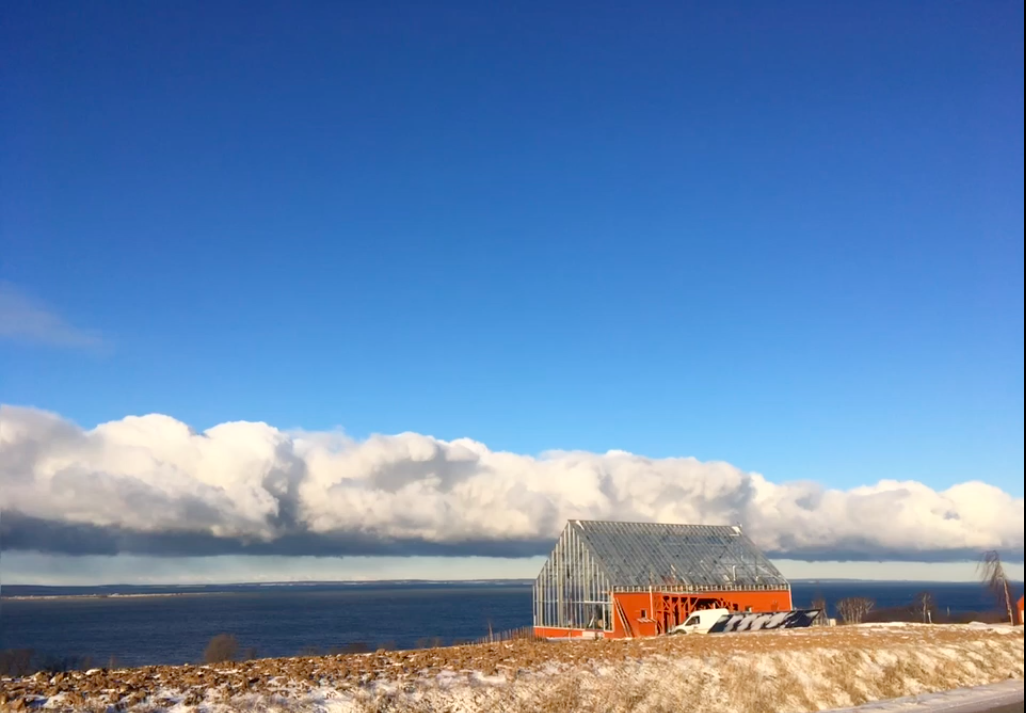Nature House – a sustainable home with locally grown food
Tellus Think Tank continues the quest to find paths towards a sustainable future. In this article we look into the budding development of “Nature Houses”. We visit Bodil Antonsson who built her own Nature House. First a few words about why the Nature House will be interesting for a sustainable future!
Text: Domi, Tellus Think Tank Photo: AnnVixen, Jana Juliana Photography & Bodil Antonsson
A few words on problems of non-local grown food
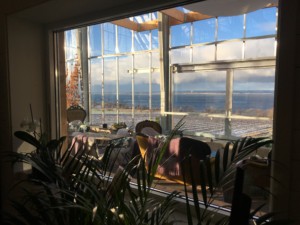
Locally produced food is not something that people living close to the poles take for granted. Winters are long and the season for growing food is singular and short.
Looking at the example of Sweden, this European country imports almost 50 % of the food needed for its 10 million inhabitants. All other foods, except for sugar that Sweden is self-sufficient in, are imported in large quantities.
Here are some examples of how food is transported to Sweden :
- In the middle of summer, Sweden’s agricultural season, Swedish shops offer green beans grown, packed and transported from Kenya, Africa.
- The vacuum packed meat, available in shops, has been shipped over the Atlantic from Argentina and Brazil.
- Th North Sea fish, is frozen and shipped to China. It is there prepared and packed to be re-shipped to be sold Sweden and other countries.
- All year around Swedes eat vegetables such as cucumber, tomatoes, broccoli, cabbages etc. that have been transported by lorry from Southern Europe countries such as Italy, Greece and Spain.
For a sustainable future
These examples are just a few examples of transport routes of food to Europe from afar. By increasing locally produced food transport and carbon emissions can be decreased and food security can be increased, because if food is produced locally fewer things can go wrong on it’s way to our plates.
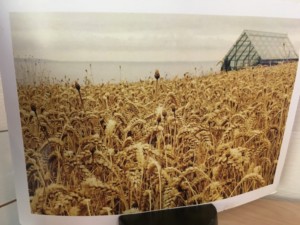
Greenhouses could be one way of prolonging the gardening season in countries with short summers but can greenhouses reduce mass-distribution of food to places like Sweden? Perhaps they need to be one of many methods of feeding populations close to the poles. How can the design of living quarters help local food production, we set out to meet Bodil Antonsson who built her own Nature House – a house surrounded by a greenhouse shell!
Also read our articles on city skyscraper greenhouses!
Arriving at the Nature House in Uppgrenna, Sweden
Bodil Antonsson has lived in the village of Gränna in Sweden almost all her life. She built her Nature House just outside of the village in an area that goes by the name Uppgrenna.
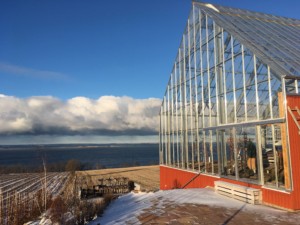
The day we arrive it is freezing, even for Sweden, and the thermometer shows -15 Celsius. My cheeks are still frozen stiff from the short walk to the car and nature shows its frosted cover of winter magic. Our trip takes us through the Swedish candy town of Gränna and when we reach the fields outside the village we almost pass Uppgrenna Nature House as it stands almost unannounced and unpretentious in the middle of the fields on the east slopes of Sweden’s second largest lake, Vättern.
Lake Vättern is steaming in the cold and Uppgrenna Nature House café is closed for the short greenhouse winter season and will re-open in February. Tellus Think Tank is the only visitor of the day. Bodil Antonsson greets us by the entrance and invites us into the large atrium-feeling greenhouse shell.
It is eleven o’clock and the temperature in the greenhouse has reached +1 Celsius. Bodil tells me the lowest point this morning was -1, before the sun rose and heated the greenhouse. The greenhouse temperature rises by another 5 degrees during our stay.
What is a Nature House?
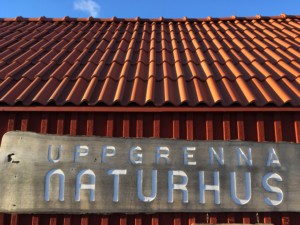
At first glance the Nature House looks like a residential house framed with a greenhouse shell – and it is in some ways, and much more, as it is designed and equipped to be sustainable:
- Harmonise with nature’s elements such as sunlight, wind, rain, snow, earth and plants.
- Be as self-sufficient as possible using systems and technology to enhance sustainability such as:
- Organic heating and cooling systems.
- Wastewater handling.
- Offering inhabitants the possibility to locally grow and fertilise their own food.
Sustainable practises in Bodil’s Nature House
Bodil tells us about some of the sustainable practises she chose for the construction of her Nature House.
- The light concrete blocks without a plastic core for the basement.
- The insulated inner building at the entry level of the Nature house is a so called low energy house with a prefabricated frame made of wood and with a cellulose insulation without plastic.
- The wood used for the inner walls have also been used to build the outer layer of the inner walls.
- When needed, Bodil chose organic or no paint.
- The circular handling of wastewater.
The Nature House is mostly heated by sun, and the greenhouse shell helps create an indoor Mediterranean climate
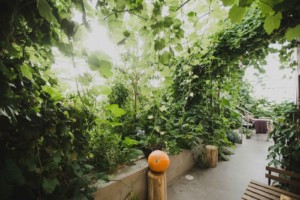
in the greenhouse that also heats the inner parts of the house. In summertime the inner house is kept cool by opening windows and with help of the normal ventilation system.
Bodil believes that she has built her Nature House according to the most sustainable practises possible with an acceptable balance between organic practises, economy and energy. She believes that future Nature Houses will be able to use even more sustainable solutions as the development of organic building practises is enhancing fast.
The use and cleansing steps of the wastewater
- In the first stage the black and grey wastewater runs into a water cleansing system.
- In the next stage the nutrient rich water is led through different agricultural beds within the house so that the plants receive both fertilizer and water at the foot of their root systems. The small part of water that is not used by the plants ends up in the outdoor pond for a last cleans by its water plants.
In summer Uppgrenna Nature House café has had 300 guests a day and every visit to the Nature House restrooms helps fertilise the agricultural beds in the areas of the Nature House that Bodil calls the Mediterranean and the Lemon Grove.
-The agricultural beds are so effective and the plants are in a euphoric state and produce lots of the food that we serve in the self-sufficient Nature House café! Says Bodil.
All food grown in the Nature House is organic
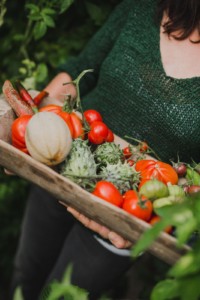
The food served in the café is 100% organic and the fruit and vegetable in the greenhouse are also pesticide-free. If Bodil finds some kind of insect assault on the plants she fights it with either soap and water or with other kinds of insect species to fight the harmful ones.
To get a natural pollination process in both the greenhouse and the lemon grove Bodil brings in bumblebees that thrive here as they fly around and visit all the plants! She hopes to one day have a native bumble-bee queen build her nest in the greenhouse and stay the winter!
She continues to share with us that the greenhouse and lemon grove need less nutrients in wintertime and that if the amount of visitors had been a steady 300 persons throughout the year she would need to add a second greenhouse!
Not everything should be grow in the agricultural beds connected to wastewater. The plant need to have roots for filtering away bacteria when bringing the water to the fruit or veggies. Carrots, for instance, are not preferable as the eatable part grows is in the ground and closer to possible findings of the wastewater bacteria.
Building pains
Bodil Antonsson had a vision of a meeting place in a greenhouse, which took her 8 years to develop and build. Bodil was inspired by a home within a greenhouse in Vänersborg. A part of Bodils building process was discussions with Anders Solvarm. She seems very grateful for his interest! The final version of the Uppgrenna Nature House is Bodil’s design.
The Swedish building regulations made it difficult to receive the needed permits for the Nature house as it
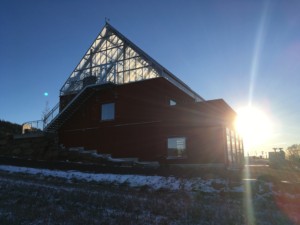
contained both new kind of construction, design and technology.
Another difficulty was the gender bias from some of the men at the communal building committee. Bodil invested both time and quite a lot of effort before she noticed that they all respected her ideas and opinions. Perseverance prevails!
In 2015, after 8 years from the original vision, Bodil’s Nature House stood ready for use! Currently Bodil runs an organic café, a light-therapy studio, green rehabilitation, guided tours and a conference business in her magnificently located house by lake Vättern!
A walk around Uppgrenna Nature House
The three story Nature House reminds locals of the beautiful old barn that once stood here. The entrance, at the top of the slope brings us into the middle floor of the house. The slope that cradles the Nature House allows even the basement large windows towards the lake.
The roof and south wall of the Nature House are built with glass and so is the west wall closest to the lake. The greenhouse roof consists of a layer of single framed security glass, that will not shard if broken.
The Mediterranean
The entrance of the house takes us into the area that Bodil calls “The Mediterranean”. Bodil named it after the
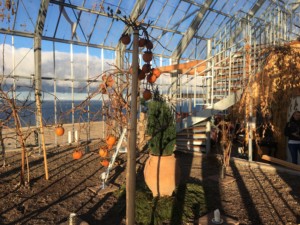
climate it holds, and it contains the first agricultural bed of the Nature House. Temperatures differ from -1 Celsius in winter to 30 degrees Celsius in summer. When the air at greenhouse roof reaches 20 degrees the ventilation hatchways open automatically and let hot air out. Bodil tells us this happened already in February last year.
Most of the year this area is full of greenery and fruit and vegetables but in the beginning of January it is mostly bare except for some exotic Sharon fruits! Greenhouse fruit and vegetables, such a figs, chilli, almonds, mulberries, grapes, tomatoes, pumpkin, cucumber, melons, horned melons (kiwanos), peaches from this area are served in the vegetarian café.
A spiral staircase up to the views of the valley of Lake Vättern
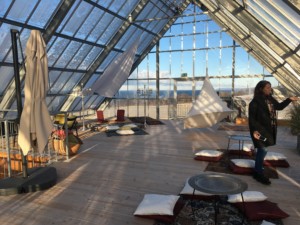
From the Mediterranean one can climb the spiral staircase up onto the inner roof of the wooden inner house. The large flat area allows Bodil to use it for both lectures, concerts and yoga. The views of the lake are just magnificent from under the glass ceiling.
From the Mediterranean we enter the well insulated, traditional falu-red, inner house, placed inside the greenhouse. Even though the temperature in the greenhouse part is colder or warmer the inner box holds a constant indoor room temperature (around 20 degrees Celsius).
The inner house, on the middle floor, holds the café kitchen and serving rooms and bathrooms. I note that the soap in the kitchen and bathrooms are all environmental friendly and Bodil assures me of the importance of organic matter in her wastewater system!
The Rainforest
In the basement Bodil has named the rooms “The Rainforest” and “The Lemon grove”. Uppgrenna Nature House
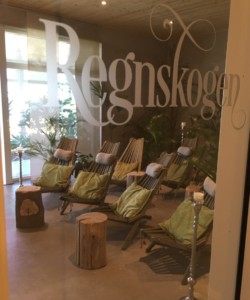
guests enjoy relaxing in The Rainforest. It is equipped with a light-therapy system. The lamps encourage the body to develop vitamin D, much needed to keep healthy during the dark, Swedish winter. Bodil serves unusual treats in the Swedish winter such as a locally grown fruit-cocktail-drinks in 27 degree Celsius heat!
The Lemon Grove
The Lemon Grove contains the second agricultural bed, connected to the sustainable, circular wastewater system. It is full of lemon and lime trees! In mid-winter, during our visit, trees are in bloom and budding fruits give the air a wonderfully zingy scent!
Costs and business
Building a meeting place in form of a Nature House needed an initial investment of 9 million Swedish crowns. Uppgrenna Nature House is doing well because of the number of high-
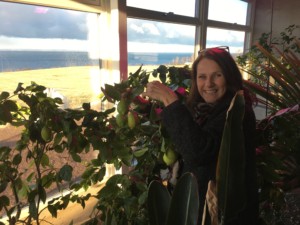
season café visitors shooting past the expected. But starting a new business is always difficult and craves large inputs of work.
Bodil often receives delegations and conferences with a special interest in the Nature House construction. She also
holds green rehabilitation, mindfulness and stress handling sessions in the Nature House. The latter three are what really makes Bodil tick! Green rehabilitation and mindfulness include a lot of quiet time, walking in nature and keeping busy with agricultural activities.
The importance of the Uppgrenna Nature House
The beauty of the Lake Vättern Valley is breathtaking, the surroundings would be good for any soul, battered or not!
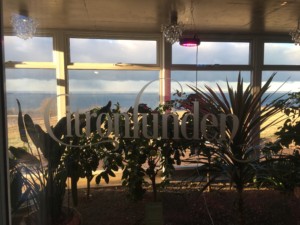
Currently the sun shines on Uppgrenna Nature House, looking out over the silvery fields above the cloud covered lake. Any artist or person with a sense of beauty would be amazed with the placement of Uppgrenna Nature House! From this sense it is an important building with the possibility of being a model for future residential homes.
The Nature House in a sustainable future
The indoor garden offers the possibility to be being self-sufficient in vegetables and fruit. The total design of Nature House’s seems, in large, very sustainable and makes me very interested in their continued development!
Nature Houses could definitely be part of the solution for a sustainable future. They would help increase local
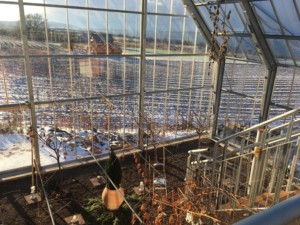
production and reduce the need of carbon emitting transports. The Nature Houses would also offer high quality lives and increased food security for their inhabitants. Tellus Think Tank would like to see more of these houses available for a larger market very soon!
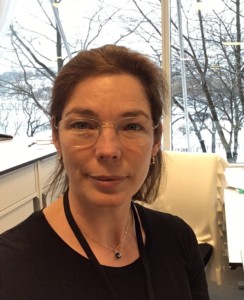
Read about city skyscraper greenhouses of the future!
More links on Nature House’s
The original inventor of Nature Houses: http://bengtwarne.malwa.nu/
A Nature House building company https://www.youtube.com/watch?v=jL4m1_BbJQc
Swedish Nature House: https://www.youtube.com/watch?v=30ghnDOFbNQ
Norwegian Nature House: https://www.youtube.com/watch?v=lc_clnBY-2I
German Nature House: https://www.youtube.com/watch?v=v2X6De1C_qU
Coming soon Dutch/US nature house residential areas: http://www.regenvillages.com/#
Share this article – for a sustainable future!
